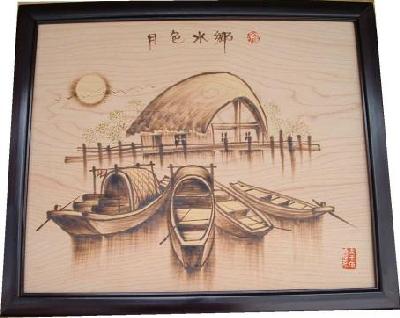
Iron picture, also called as Wuhu Iron Picture, is a cross between painting and sculpture. It was first created by Tang Tianchi, a blacksmith who lived in Wuhu of Anhui Province in the mid 17th century. Using the anvil as his inkstone and the hammer as his brush, he forged, filed and shaped iron strips and wires into pictures by following the principles of composition of the Chinese painting.
This art developed by the smith-artist has been handed down and cultivated for three hundred years. The picture in iron is normally painted black, with or without luster, which forms a clear contrast with the light colored wall on which it is hung. The landscapes, flowers and plants represented in iron appeal to viewers with a three dimensional effect of simplicity and boldness rarely found elsewhere.
The craft combines the traditional techniques of Chinese painting and calligraphy, sculpture, and paper cutting. It uses iron as the drawing brush, through the process of smelting, forge drilling and filing, iron is made into pictures of high art value. Iron picture is to hot-etch a picture on a piece of wood, using the changes and variation of the dark and light shades on the wood to express the artist's thinking. It characterizes the simplicity and nature, typically by using the wood mechanism. To make use of the grain in the wood is a character of ironed picture. It possesses high value of appreciation and collection.
Following Tang Tianchi, the initiator of iron picture, another celebrated iron picture artisan named Liang Yingda emerged. Subsequently, there were no other really outstanding masters, but the art was handed down from generation to generation by skillful craftsmen. Now iron pictures are not only favorite artistic ornaments for ordinary people but also displayed in national level guesthouses or halls, demonstrating the unique artistic charm of suiting both refined and popular tastes and being really superb.










